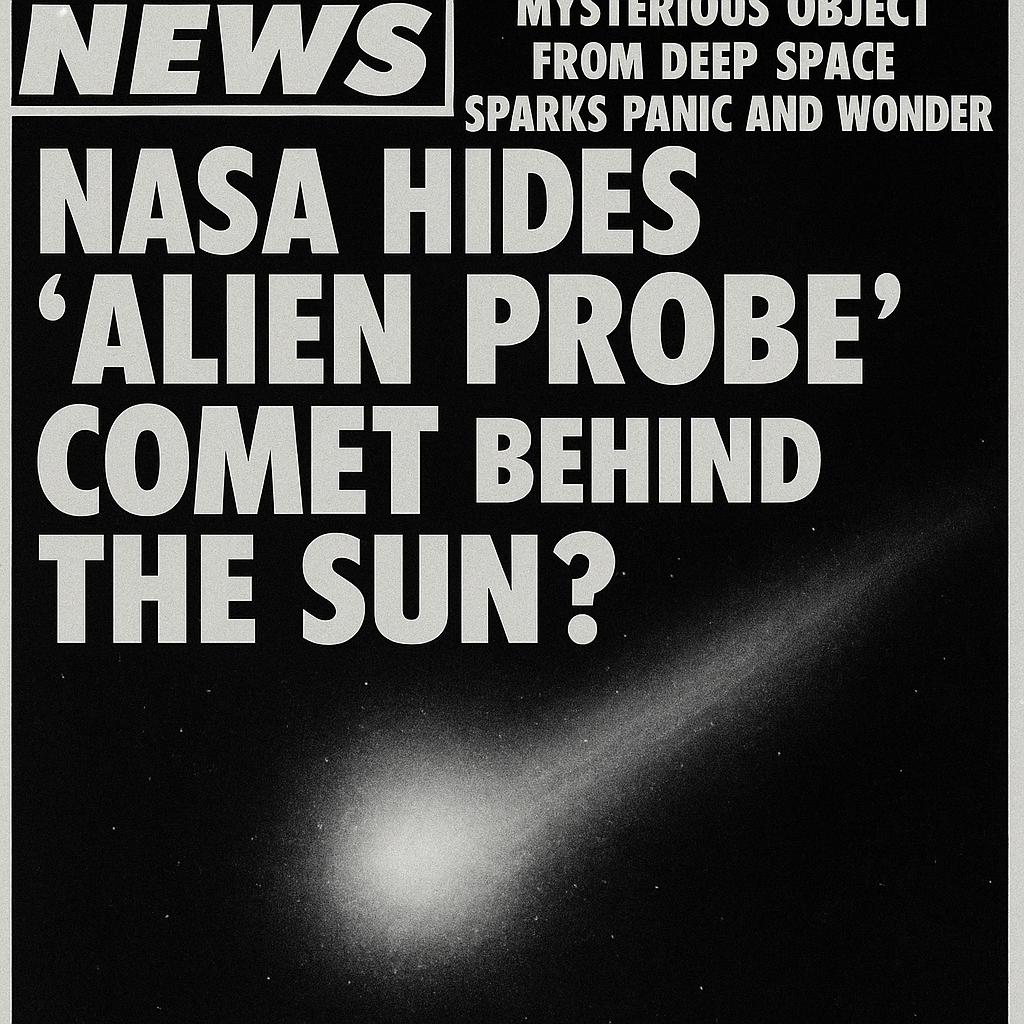
NASA HIDES “ALIEN PROBE” COMET BEHIND THE SUN?!
MYSTERIOUS OBJECT FROM DEEP SPACE SPARKS PANIC AND WONDER
Is NASA covering up an alien spacecraft? Is a cosmic spy probe sneaking through our solar system under the cover of a comet’s tail?
Astronomers around the world are buzzing about 3I/ATLAS, a bizarre interstellar object caught hurtling through the solar system at breakneck speed. It’s only the third of its kind ever spotted—after the cigar-shaped mystery of ’Oumuamua in 2017 and the ghostly 2I/Borisov in 2019. Unlike those, ATLAS is putting on a show: glowing fuzz, streaming dust, even water vapor billowing off its frozen surface at 40 kilograms a second.
If that doesn’t sound like a spaceship firing its thrusters… well, keep reading.
A GALACTIC INTRUDER
Scientists confirmed what the conspiracy crowd already suspected: this thing isn’t from around here. Its orbit isn’t a neat ellipse like planets and comets born in our system. Instead it’s hyperbolic—a curve that screams: fly-by tourist from another star.
Estimates suggest it could be anywhere from a third of a mile to over three miles wide. Big enough to hide a fleet of saucers. Or, more likely, big enough to survive billions of years drifting through interstellar space before ATLAS’s telescopes in Chile caught it on July 1, 2025.
SUDDENLY, WE’RE SEEING THEM EVERYWHERE
So why are alien-hunting headlines popping up more and more? Did the galaxy just decide to start flinging junk at us?
Nope—the difference is our eyes got sharper. Surveys like Pan-STARRS and ATLAS scan the sky night after night, catching faint, fast objects that older telescopes would miss. Throw in better star maps from ESA’s Gaia mission and some heavy-duty orbital math, and suddenly Earthlings can tell the difference between “just another comet” and “holy crap, that rock came from another star.”
For all of human history we saw zero. Now, in less than a decade, we’ve bagged three confirmed interstellar visitors. The floodgates are open.
THE ALIEN PROBE THEORY
Here’s where things get juicy. Harvard astrophysicist Avi Loeb—the same guy who argued ’Oumuamua might’ve been alien tech—says 3I/ATLAS deserves a hard look.
Why?
- It shines strangely, with a forward glow not typical of normal comets.
- Its trajectory is oddly convenient—disappearing behind the Sun at perihelion, exactly when telescopes can’t see it.
- And it’s active way farther out than expected, like it’s firing up early.
Loeb isn’t claiming little green men, but he’s not ruling out alien engineering either. He’s even calling for NASA to redirect spacecraft—like Juno at Jupiter or orbiters at Mars—to intercept it before it vanishes forever in 2026.
WHAT THE “OFFICIAL STORY” SAYS
Most scientists say: calm down, it’s just a comet. Their argument:
- Hubble has imaged the fuzzy coma and set a firm upper limit on its size.
- James Webb has already captured infrared spectra, which will reveal whether its ices are made of the same stuff as our comets or something exotic.
- Its spin, dust release, and chemistry so far look more like a natural iceball than a cloaked mothership.
And yes—it’s no threat to Earth. At closest approach it’ll still be about 1.8 astronomical units away, safely beyond Mars’s orbit. No War of the Worlds this time.
THE REAL SHOCKER
Even if it isn’t alien tech, 3I/ATLAS is still jaw-dropping. It may have formed seven billion years ago in the Milky Way’s thick disk, long before our Sun existed. That makes it not just an interstellar comet—but potentially the oldest chunk of another planetary system we’ve ever touched with telescopes.
Imagine peering at an object older than the Earth itself, a piece of galactic history drifting into our neighborhood by cosmic accident.
SO… SPACESHIP OR SNOWBALL?
Here’s the tabloid bottom line:
- Could it be alien? Sure, if you want to dream.
- Is it a natural comet? Almost certainly.
- Is it still incredible? Absolutely—it’s a visitor from another star, caught in the act of shedding its secrets under the gaze of our best telescopes.
NASA may not be hiding an alien probe behind the Sun. But for the first time in history, we’re finally catching the galaxy’s wandering icebergs in real time—and that’s no less sensational.


